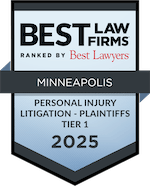Bicycle Accidents - Kids and Bikes
It's summer and kids are hitting the roads and trails on their bikes. So now is a great time to sit down with your young roadsters and talk about bike safety.
Consider this: Every year, bicycle accidents kill more than 300 children, 14 years old and under. And 400,000 children are treated in emergency rooms for bike-related injuries. Adults are not immune to bicycle accidents either.
Hurt biking?
At SiebenCarey, we are dedicated to preventing accidents before they happen. But if you or your child has been hurt in a bicycle accident call the "Know Your Rights" attorneys. With more than 65 years of experience, we are one of Minnesota's leading personal injury law firms. With our expert health care consultants, we anticipate future therapy or special training for our clients that many others may not consider. You can rest assured that our seasoned attorneys will protect both the short- and long-term interests of your child.
Avoid bike accidents by practicing the following safety tips:
- Remember that your bicycle is subject to the same regulations as motorists. Obey all traffic signs and signals.
- Ride with traffic as close to the right side of the road as possible. Watch for grates, opening car doors and soft shoulders.
- Signal all turns and stops so drivers know your intentions.
- Obey the right-of-way rules. Yield to pedestrians.
- Pass to the left of a slower vehicle or pedestrian. Give an audible signal or use a bell or electric horn before overtaking.
- Only ride after dark if your bike has a headlight, taillight and reflectors as required by law. Wear light-colored clothing or a reflective vest and leg bands.
- Always wear a helmet.
Heads up
One out of three bike-related injuries involves a head injury. When worn correctly, bike helmets can reduce the risk of head injury by 85 percent. A properly fitted helmet should rest level on the top of the head and should not slide around. Because children's heads vary widely in shape and size, use foam pads so helmets fit snugly and feel comfortable. Position the helmet to cover as much of the head as possible, including the forehead. When the strap is fastened, the helmet should fit securely with enough space to put one finger between the child's chin and the helmet buckle.
Verdicts and Settlements






